Analyzing HRM Practices: Resourcing and Effectiveness at Tesco Company
VerifiedAdded on 2023/01/13
|16
|4971
|49
Report
AI Summary
This report provides a comprehensive analysis of Human Resource Management (HRM) practices within Tesco, a British multinational grocery retail store. It explores the purpose and scope of HRM in resourcing the organization, including recruitment and selection processes, training and development programs, and employee relations strategies. The report evaluates the effectiveness of various HRM practices, such as reward systems and performance appraisals, from both the employee and employer perspectives, examining their impact on organizational profitability. Internal and external recruitment methods are discussed, along with their strengths and weaknesses. Additionally, the report outlines the steps involved in the selection process, from preliminary interviews to final hiring decisions. The overall aim is to provide insights into how HRM practices contribute to achieving organizational objectives and maintaining a competitive advantage within Tesco. Desklib offers similar solved assignments and past papers for students.

Human Resource
Management
Management
Paraphrase This Document
Need a fresh take? Get an instant paraphrase of this document with our AI Paraphraser

Table of Contents
Introduction:.....................................................................................................................................4
Lo 1:............................................................................................................................................4
Explain the purpose and scope of HRM in terms of resourcing an organisation. .............4
Lo 2: Evaluate the effectiveness of the different HRM practices of organisation for the
employee-employer.....................................................................................................................7
LO 3: Analyse the factors that affect the HRM decision-making including employment..........8
LO4 :Applying HRM practices in the organisation. .................................................................9
Conclusion: ...................................................................................................................................11
References:.......................................................................................................................................1
Introduction:.....................................................................................................................................4
Lo 1:............................................................................................................................................4
Explain the purpose and scope of HRM in terms of resourcing an organisation. .............4
Lo 2: Evaluate the effectiveness of the different HRM practices of organisation for the
employee-employer.....................................................................................................................7
LO 3: Analyse the factors that affect the HRM decision-making including employment..........8
LO4 :Applying HRM practices in the organisation. .................................................................9
Conclusion: ...................................................................................................................................11
References:.......................................................................................................................................1

⊘ This is a preview!⊘
Do you want full access?
Subscribe today to unlock all pages.

Trusted by 1+ million students worldwide
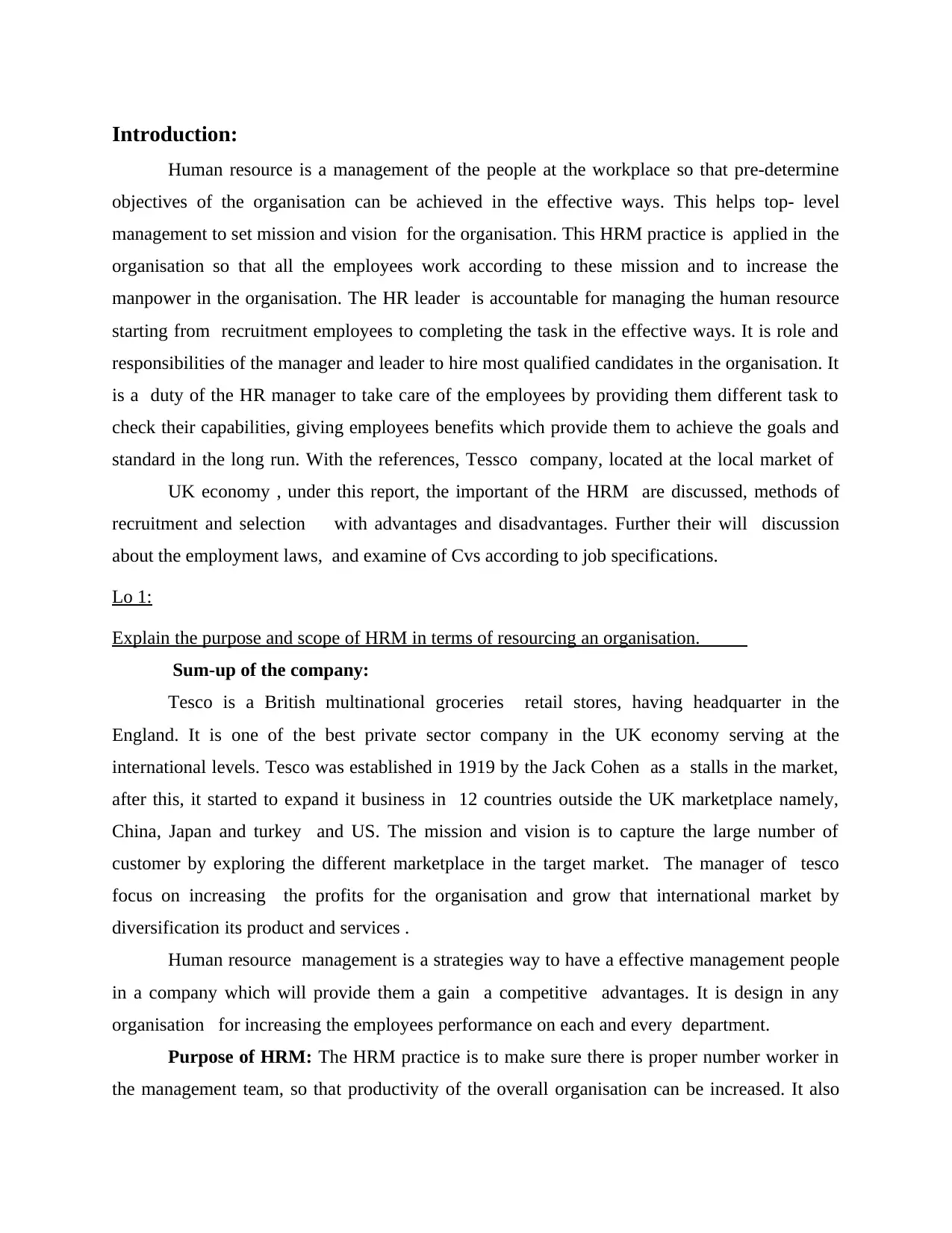
Introduction:
Human resource is a management of the people at the workplace so that pre-determine
objectives of the organisation can be achieved in the effective ways. This helps top- level
management to set mission and vision for the organisation. This HRM practice is applied in the
organisation so that all the employees work according to these mission and to increase the
manpower in the organisation. The HR leader is accountable for managing the human resource
starting from recruitment employees to completing the task in the effective ways. It is role and
responsibilities of the manager and leader to hire most qualified candidates in the organisation. It
is a duty of the HR manager to take care of the employees by providing them different task to
check their capabilities, giving employees benefits which provide them to achieve the goals and
standard in the long run. With the references, Tessco company, located at the local market of
UK economy , under this report, the important of the HRM are discussed, methods of
recruitment and selection with advantages and disadvantages. Further their will discussion
about the employment laws, and examine of Cvs according to job specifications.
Lo 1:
Explain the purpose and scope of HRM in terms of resourcing an organisation.
Sum-up of the company:
Tesco is a British multinational groceries retail stores, having headquarter in the
England. It is one of the best private sector company in the UK economy serving at the
international levels. Tesco was established in 1919 by the Jack Cohen as a stalls in the market,
after this, it started to expand it business in 12 countries outside the UK marketplace namely,
China, Japan and turkey and US. The mission and vision is to capture the large number of
customer by exploring the different marketplace in the target market. The manager of tesco
focus on increasing the profits for the organisation and grow that international market by
diversification its product and services .
Human resource management is a strategies way to have a effective management people
in a company which will provide them a gain a competitive advantages. It is design in any
organisation for increasing the employees performance on each and every department.
Purpose of HRM: The HRM practice is to make sure there is proper number worker in
the management team, so that productivity of the overall organisation can be increased. It also
Human resource is a management of the people at the workplace so that pre-determine
objectives of the organisation can be achieved in the effective ways. This helps top- level
management to set mission and vision for the organisation. This HRM practice is applied in the
organisation so that all the employees work according to these mission and to increase the
manpower in the organisation. The HR leader is accountable for managing the human resource
starting from recruitment employees to completing the task in the effective ways. It is role and
responsibilities of the manager and leader to hire most qualified candidates in the organisation. It
is a duty of the HR manager to take care of the employees by providing them different task to
check their capabilities, giving employees benefits which provide them to achieve the goals and
standard in the long run. With the references, Tessco company, located at the local market of
UK economy , under this report, the important of the HRM are discussed, methods of
recruitment and selection with advantages and disadvantages. Further their will discussion
about the employment laws, and examine of Cvs according to job specifications.
Lo 1:
Explain the purpose and scope of HRM in terms of resourcing an organisation.
Sum-up of the company:
Tesco is a British multinational groceries retail stores, having headquarter in the
England. It is one of the best private sector company in the UK economy serving at the
international levels. Tesco was established in 1919 by the Jack Cohen as a stalls in the market,
after this, it started to expand it business in 12 countries outside the UK marketplace namely,
China, Japan and turkey and US. The mission and vision is to capture the large number of
customer by exploring the different marketplace in the target market. The manager of tesco
focus on increasing the profits for the organisation and grow that international market by
diversification its product and services .
Human resource management is a strategies way to have a effective management people
in a company which will provide them a gain a competitive advantages. It is design in any
organisation for increasing the employees performance on each and every department.
Purpose of HRM: The HRM practice is to make sure there is proper number worker in
the management team, so that productivity of the overall organisation can be increased. It also
Paraphrase This Document
Need a fresh take? Get an instant paraphrase of this document with our AI Paraphraser
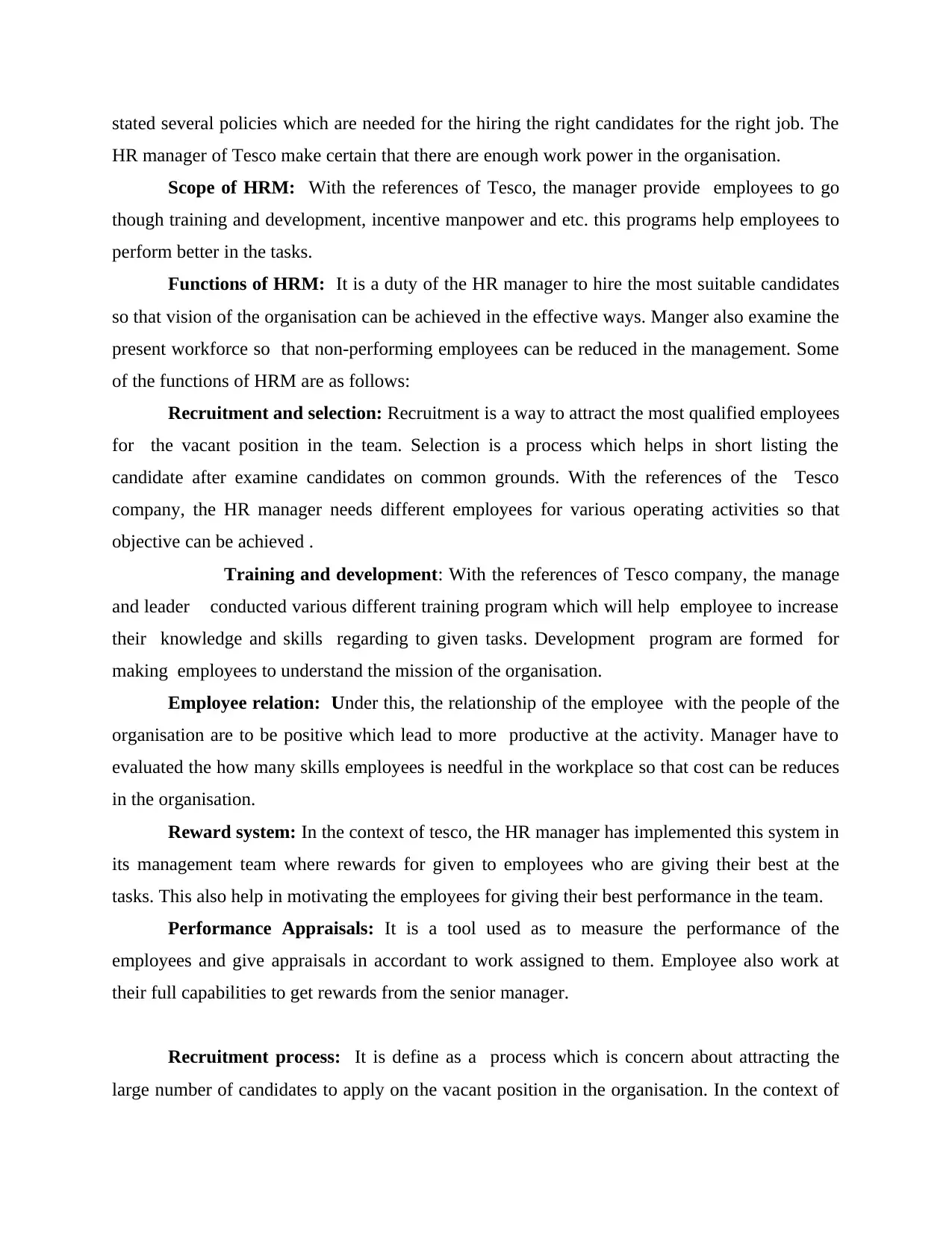
stated several policies which are needed for the hiring the right candidates for the right job. The
HR manager of Tesco make certain that there are enough work power in the organisation.
Scope of HRM: With the references of Tesco, the manager provide employees to go
though training and development, incentive manpower and etc. this programs help employees to
perform better in the tasks.
Functions of HRM: It is a duty of the HR manager to hire the most suitable candidates
so that vision of the organisation can be achieved in the effective ways. Manger also examine the
present workforce so that non-performing employees can be reduced in the management. Some
of the functions of HRM are as follows:
Recruitment and selection: Recruitment is a way to attract the most qualified employees
for the vacant position in the team. Selection is a process which helps in short listing the
candidate after examine candidates on common grounds. With the references of the Tesco
company, the HR manager needs different employees for various operating activities so that
objective can be achieved .
Training and development: With the references of Tesco company, the manage
and leader conducted various different training program which will help employee to increase
their knowledge and skills regarding to given tasks. Development program are formed for
making employees to understand the mission of the organisation.
Employee relation: Under this, the relationship of the employee with the people of the
organisation are to be positive which lead to more productive at the activity. Manager have to
evaluated the how many skills employees is needful in the workplace so that cost can be reduces
in the organisation.
Reward system: In the context of tesco, the HR manager has implemented this system in
its management team where rewards for given to employees who are giving their best at the
tasks. This also help in motivating the employees for giving their best performance in the team.
Performance Appraisals: It is a tool used as to measure the performance of the
employees and give appraisals in accordant to work assigned to them. Employee also work at
their full capabilities to get rewards from the senior manager.
Recruitment process: It is define as a process which is concern about attracting the
large number of candidates to apply on the vacant position in the organisation. In the context of
HR manager of Tesco make certain that there are enough work power in the organisation.
Scope of HRM: With the references of Tesco, the manager provide employees to go
though training and development, incentive manpower and etc. this programs help employees to
perform better in the tasks.
Functions of HRM: It is a duty of the HR manager to hire the most suitable candidates
so that vision of the organisation can be achieved in the effective ways. Manger also examine the
present workforce so that non-performing employees can be reduced in the management. Some
of the functions of HRM are as follows:
Recruitment and selection: Recruitment is a way to attract the most qualified employees
for the vacant position in the team. Selection is a process which helps in short listing the
candidate after examine candidates on common grounds. With the references of the Tesco
company, the HR manager needs different employees for various operating activities so that
objective can be achieved .
Training and development: With the references of Tesco company, the manage
and leader conducted various different training program which will help employee to increase
their knowledge and skills regarding to given tasks. Development program are formed for
making employees to understand the mission of the organisation.
Employee relation: Under this, the relationship of the employee with the people of the
organisation are to be positive which lead to more productive at the activity. Manager have to
evaluated the how many skills employees is needful in the workplace so that cost can be reduces
in the organisation.
Reward system: In the context of tesco, the HR manager has implemented this system in
its management team where rewards for given to employees who are giving their best at the
tasks. This also help in motivating the employees for giving their best performance in the team.
Performance Appraisals: It is a tool used as to measure the performance of the
employees and give appraisals in accordant to work assigned to them. Employee also work at
their full capabilities to get rewards from the senior manager.
Recruitment process: It is define as a process which is concern about attracting the
large number of candidates to apply on the vacant position in the organisation. In the context of
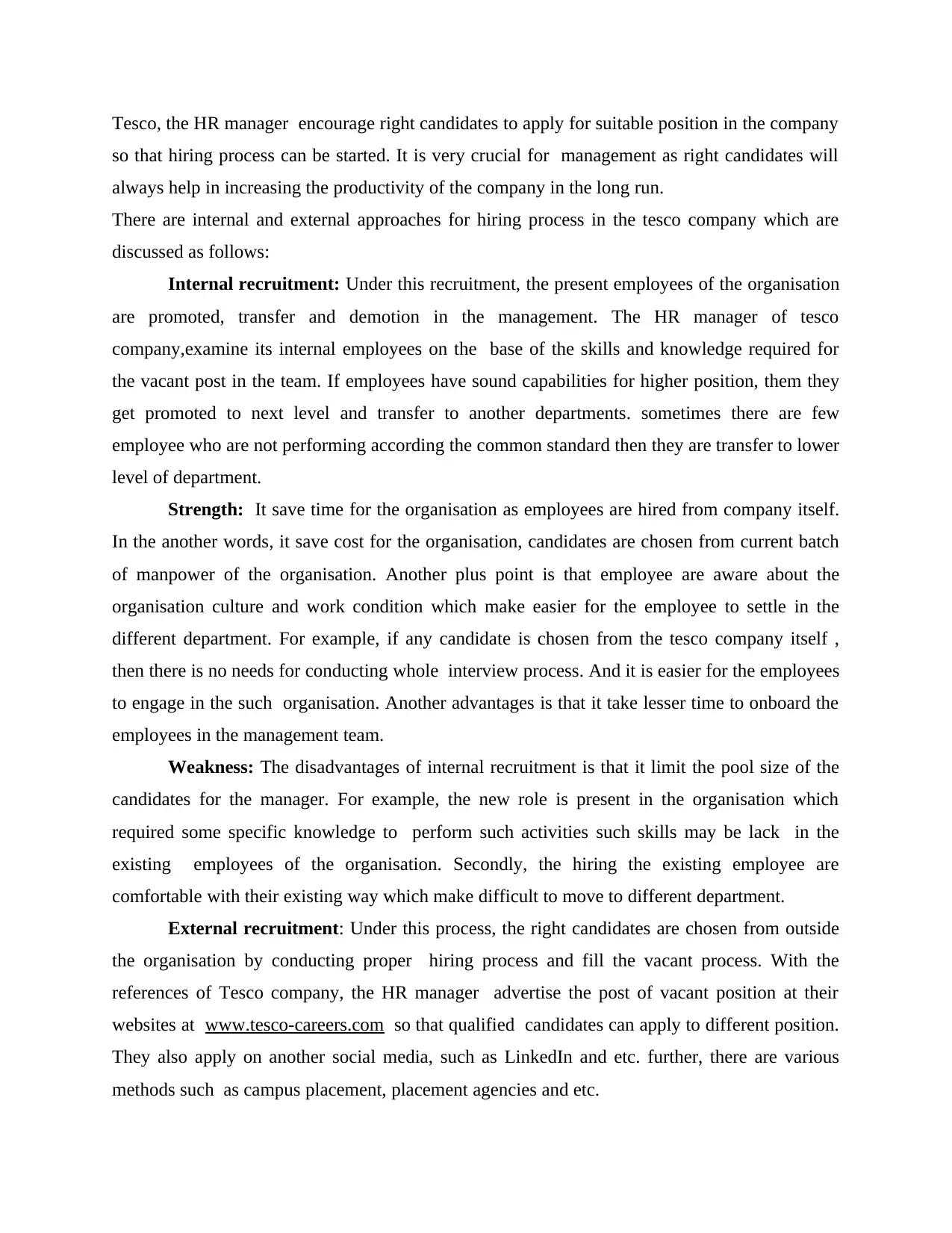
Tesco, the HR manager encourage right candidates to apply for suitable position in the company
so that hiring process can be started. It is very crucial for management as right candidates will
always help in increasing the productivity of the company in the long run.
There are internal and external approaches for hiring process in the tesco company which are
discussed as follows:
Internal recruitment: Under this recruitment, the present employees of the organisation
are promoted, transfer and demotion in the management. The HR manager of tesco
company,examine its internal employees on the base of the skills and knowledge required for
the vacant post in the team. If employees have sound capabilities for higher position, them they
get promoted to next level and transfer to another departments. sometimes there are few
employee who are not performing according the common standard then they are transfer to lower
level of department.
Strength: It save time for the organisation as employees are hired from company itself.
In the another words, it save cost for the organisation, candidates are chosen from current batch
of manpower of the organisation. Another plus point is that employee are aware about the
organisation culture and work condition which make easier for the employee to settle in the
different department. For example, if any candidate is chosen from the tesco company itself ,
then there is no needs for conducting whole interview process. And it is easier for the employees
to engage in the such organisation. Another advantages is that it take lesser time to onboard the
employees in the management team.
Weakness: The disadvantages of internal recruitment is that it limit the pool size of the
candidates for the manager. For example, the new role is present in the organisation which
required some specific knowledge to perform such activities such skills may be lack in the
existing employees of the organisation. Secondly, the hiring the existing employee are
comfortable with their existing way which make difficult to move to different department.
External recruitment: Under this process, the right candidates are chosen from outside
the organisation by conducting proper hiring process and fill the vacant process. With the
references of Tesco company, the HR manager advertise the post of vacant position at their
websites at www.tesco-careers.com so that qualified candidates can apply to different position.
They also apply on another social media, such as LinkedIn and etc. further, there are various
methods such as campus placement, placement agencies and etc.
so that hiring process can be started. It is very crucial for management as right candidates will
always help in increasing the productivity of the company in the long run.
There are internal and external approaches for hiring process in the tesco company which are
discussed as follows:
Internal recruitment: Under this recruitment, the present employees of the organisation
are promoted, transfer and demotion in the management. The HR manager of tesco
company,examine its internal employees on the base of the skills and knowledge required for
the vacant post in the team. If employees have sound capabilities for higher position, them they
get promoted to next level and transfer to another departments. sometimes there are few
employee who are not performing according the common standard then they are transfer to lower
level of department.
Strength: It save time for the organisation as employees are hired from company itself.
In the another words, it save cost for the organisation, candidates are chosen from current batch
of manpower of the organisation. Another plus point is that employee are aware about the
organisation culture and work condition which make easier for the employee to settle in the
different department. For example, if any candidate is chosen from the tesco company itself ,
then there is no needs for conducting whole interview process. And it is easier for the employees
to engage in the such organisation. Another advantages is that it take lesser time to onboard the
employees in the management team.
Weakness: The disadvantages of internal recruitment is that it limit the pool size of the
candidates for the manager. For example, the new role is present in the organisation which
required some specific knowledge to perform such activities such skills may be lack in the
existing employees of the organisation. Secondly, the hiring the existing employee are
comfortable with their existing way which make difficult to move to different department.
External recruitment: Under this process, the right candidates are chosen from outside
the organisation by conducting proper hiring process and fill the vacant process. With the
references of Tesco company, the HR manager advertise the post of vacant position at their
websites at www.tesco-careers.com so that qualified candidates can apply to different position.
They also apply on another social media, such as LinkedIn and etc. further, there are various
methods such as campus placement, placement agencies and etc.
⊘ This is a preview!⊘
Do you want full access?
Subscribe today to unlock all pages.

Trusted by 1+ million students worldwide

strength: The most qualified candidates are selected for the organisation so that
organisation have a skills people in the management team. Here right candidates are selected for
the right position in the team.
Weaknesses: it is difficult for the candidates to adjust into new work environment as
they have little understanding about the organisation. In the context of tesco, it is time
consuming as well as expense process for hiring from outside sources.
The selection process:
Selection is refers as a process of choosing the individuals out the pool of application which have
required qualification according to the vacant positions. Following are the steps which are
followed to select the candidate for the organisation.
Preliminary interview: under this process, unqualified candidates are eliminate from selection
process based on the information present in the application forms.
Strength: the skilled candidates can be selected for the further around.
Weakness: sometimes candidates with good attitudes are eliminate due to weak application.
Selection tests: candidates who past the first step are called for tests, which are based on
requirement of position.’
Strength: the candidates are examined on the basis of test which shows their skills for the
position.
Weakness: the applicants are not able to understand the test and get eliminated from the
process.
Interview: here , the selected applicants have interview with the HR team , it can be one to one,
panel interview which will helps in understanding the candidates.
Strength: the in-depth knowledge about the candidates are known to the interviewer.
Weakness: the candidates are not able express their view in front of the interviewer.
Selection decision: the final decision is to made to hire the applicants after he has passed the
preliminary interview, test and personal interview.
Strength: its helps in choosing the right candidates for the organisation.
Weakness: this can create confusion among the interviewer to whom to select.
organisation have a skills people in the management team. Here right candidates are selected for
the right position in the team.
Weaknesses: it is difficult for the candidates to adjust into new work environment as
they have little understanding about the organisation. In the context of tesco, it is time
consuming as well as expense process for hiring from outside sources.
The selection process:
Selection is refers as a process of choosing the individuals out the pool of application which have
required qualification according to the vacant positions. Following are the steps which are
followed to select the candidate for the organisation.
Preliminary interview: under this process, unqualified candidates are eliminate from selection
process based on the information present in the application forms.
Strength: the skilled candidates can be selected for the further around.
Weakness: sometimes candidates with good attitudes are eliminate due to weak application.
Selection tests: candidates who past the first step are called for tests, which are based on
requirement of position.’
Strength: the candidates are examined on the basis of test which shows their skills for the
position.
Weakness: the applicants are not able to understand the test and get eliminated from the
process.
Interview: here , the selected applicants have interview with the HR team , it can be one to one,
panel interview which will helps in understanding the candidates.
Strength: the in-depth knowledge about the candidates are known to the interviewer.
Weakness: the candidates are not able express their view in front of the interviewer.
Selection decision: the final decision is to made to hire the applicants after he has passed the
preliminary interview, test and personal interview.
Strength: its helps in choosing the right candidates for the organisation.
Weakness: this can create confusion among the interviewer to whom to select.
Paraphrase This Document
Need a fresh take? Get an instant paraphrase of this document with our AI Paraphraser
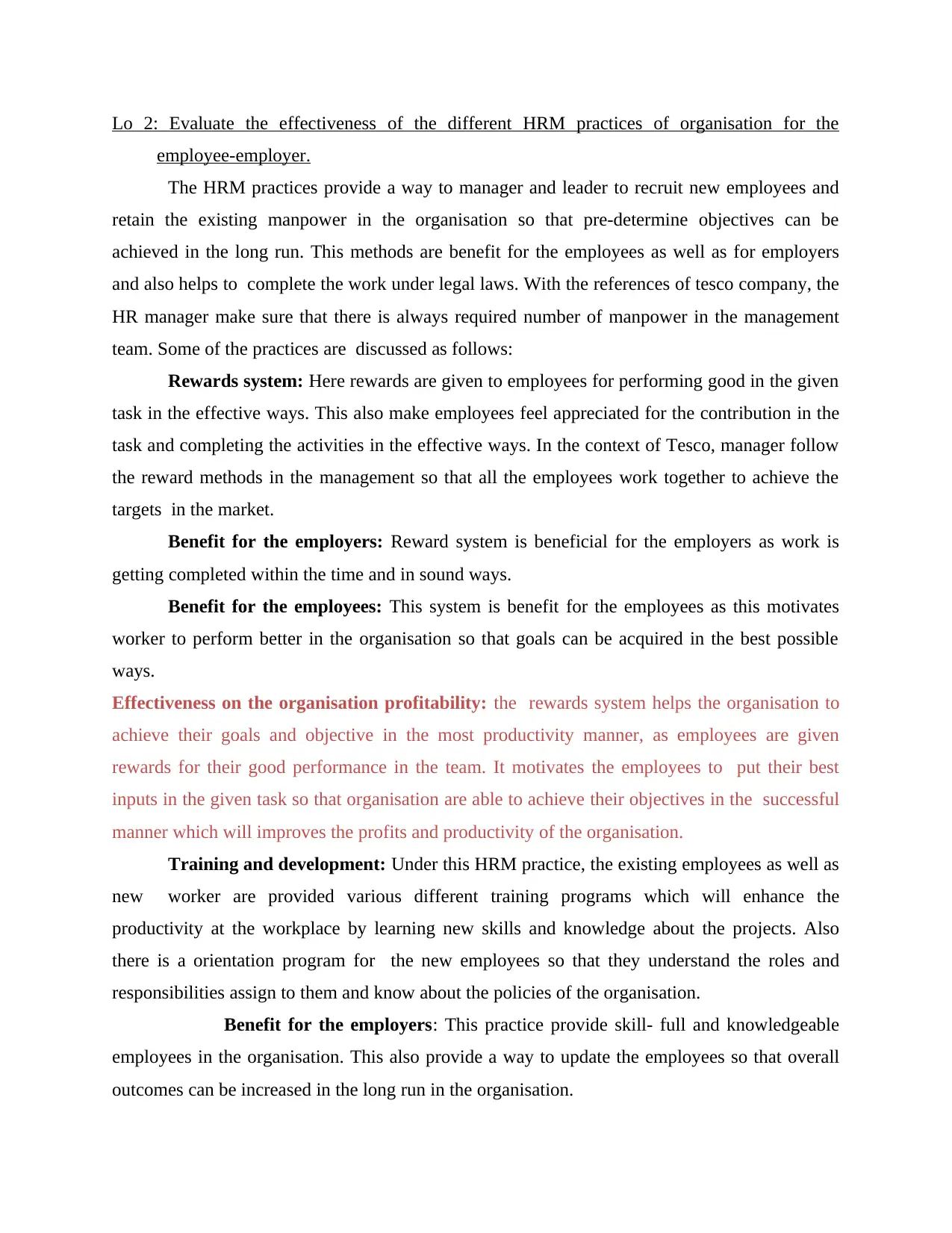
Lo 2: Evaluate the effectiveness of the different HRM practices of organisation for the
employee-employer.
The HRM practices provide a way to manager and leader to recruit new employees and
retain the existing manpower in the organisation so that pre-determine objectives can be
achieved in the long run. This methods are benefit for the employees as well as for employers
and also helps to complete the work under legal laws. With the references of tesco company, the
HR manager make sure that there is always required number of manpower in the management
team. Some of the practices are discussed as follows:
Rewards system: Here rewards are given to employees for performing good in the given
task in the effective ways. This also make employees feel appreciated for the contribution in the
task and completing the activities in the effective ways. In the context of Tesco, manager follow
the reward methods in the management so that all the employees work together to achieve the
targets in the market.
Benefit for the employers: Reward system is beneficial for the employers as work is
getting completed within the time and in sound ways.
Benefit for the employees: This system is benefit for the employees as this motivates
worker to perform better in the organisation so that goals can be acquired in the best possible
ways.
Effectiveness on the organisation profitability: the rewards system helps the organisation to
achieve their goals and objective in the most productivity manner, as employees are given
rewards for their good performance in the team. It motivates the employees to put their best
inputs in the given task so that organisation are able to achieve their objectives in the successful
manner which will improves the profits and productivity of the organisation.
Training and development: Under this HRM practice, the existing employees as well as
new worker are provided various different training programs which will enhance the
productivity at the workplace by learning new skills and knowledge about the projects. Also
there is a orientation program for the new employees so that they understand the roles and
responsibilities assign to them and know about the policies of the organisation.
Benefit for the employers: This practice provide skill- full and knowledgeable
employees in the organisation. This also provide a way to update the employees so that overall
outcomes can be increased in the long run in the organisation.
employee-employer.
The HRM practices provide a way to manager and leader to recruit new employees and
retain the existing manpower in the organisation so that pre-determine objectives can be
achieved in the long run. This methods are benefit for the employees as well as for employers
and also helps to complete the work under legal laws. With the references of tesco company, the
HR manager make sure that there is always required number of manpower in the management
team. Some of the practices are discussed as follows:
Rewards system: Here rewards are given to employees for performing good in the given
task in the effective ways. This also make employees feel appreciated for the contribution in the
task and completing the activities in the effective ways. In the context of Tesco, manager follow
the reward methods in the management so that all the employees work together to achieve the
targets in the market.
Benefit for the employers: Reward system is beneficial for the employers as work is
getting completed within the time and in sound ways.
Benefit for the employees: This system is benefit for the employees as this motivates
worker to perform better in the organisation so that goals can be acquired in the best possible
ways.
Effectiveness on the organisation profitability: the rewards system helps the organisation to
achieve their goals and objective in the most productivity manner, as employees are given
rewards for their good performance in the team. It motivates the employees to put their best
inputs in the given task so that organisation are able to achieve their objectives in the successful
manner which will improves the profits and productivity of the organisation.
Training and development: Under this HRM practice, the existing employees as well as
new worker are provided various different training programs which will enhance the
productivity at the workplace by learning new skills and knowledge about the projects. Also
there is a orientation program for the new employees so that they understand the roles and
responsibilities assign to them and know about the policies of the organisation.
Benefit for the employers: This practice provide skill- full and knowledgeable
employees in the organisation. This also provide a way to update the employees so that overall
outcomes can be increased in the long run in the organisation.
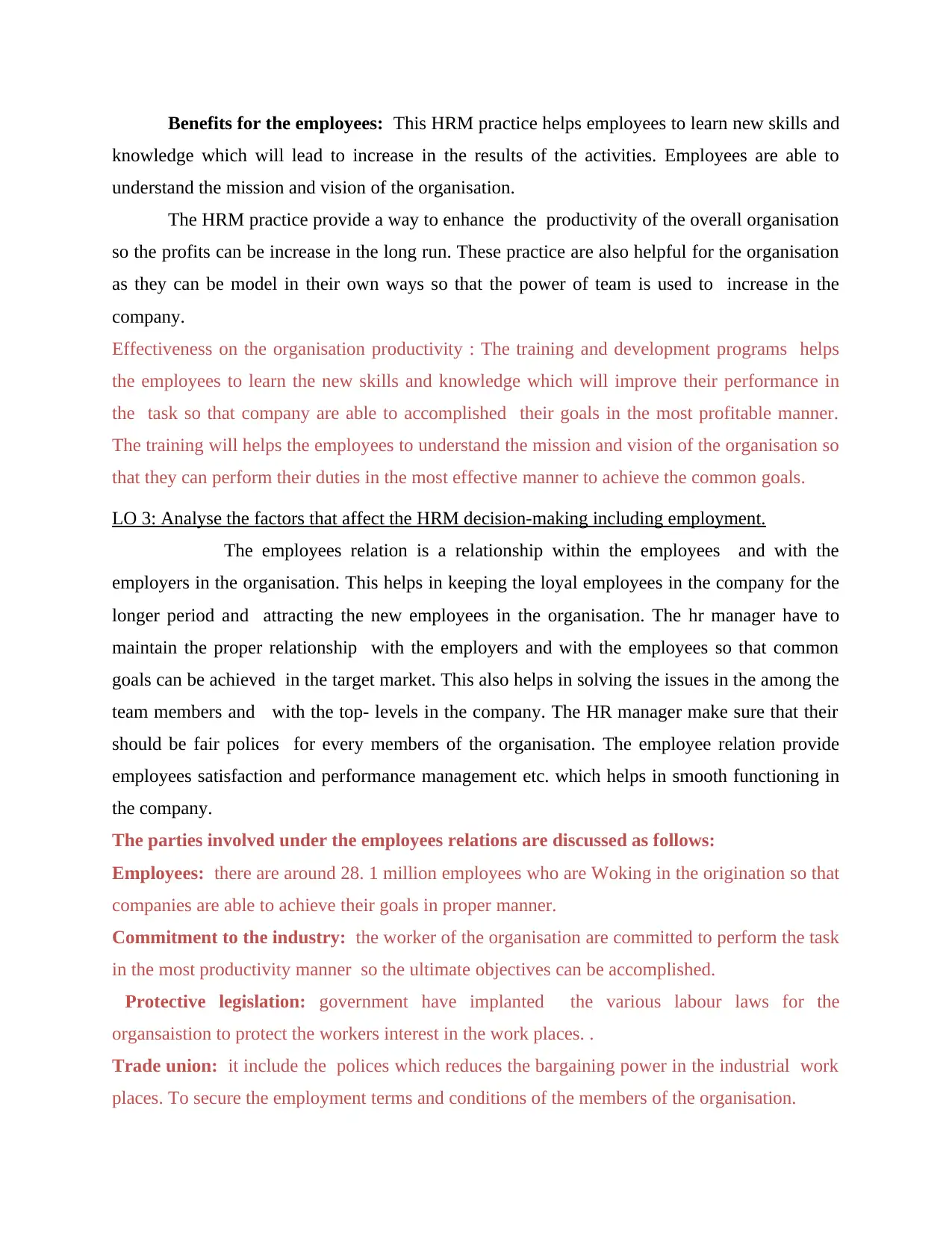
Benefits for the employees: This HRM practice helps employees to learn new skills and
knowledge which will lead to increase in the results of the activities. Employees are able to
understand the mission and vision of the organisation.
The HRM practice provide a way to enhance the productivity of the overall organisation
so the profits can be increase in the long run. These practice are also helpful for the organisation
as they can be model in their own ways so that the power of team is used to increase in the
company.
Effectiveness on the organisation productivity : The training and development programs helps
the employees to learn the new skills and knowledge which will improve their performance in
the task so that company are able to accomplished their goals in the most profitable manner.
The training will helps the employees to understand the mission and vision of the organisation so
that they can perform their duties in the most effective manner to achieve the common goals.
LO 3: Analyse the factors that affect the HRM decision-making including employment.
The employees relation is a relationship within the employees and with the
employers in the organisation. This helps in keeping the loyal employees in the company for the
longer period and attracting the new employees in the organisation. The hr manager have to
maintain the proper relationship with the employers and with the employees so that common
goals can be achieved in the target market. This also helps in solving the issues in the among the
team members and with the top- levels in the company. The HR manager make sure that their
should be fair polices for every members of the organisation. The employee relation provide
employees satisfaction and performance management etc. which helps in smooth functioning in
the company.
The parties involved under the employees relations are discussed as follows:
Employees: there are around 28. 1 million employees who are Woking in the origination so that
companies are able to achieve their goals in proper manner.
Commitment to the industry: the worker of the organisation are committed to perform the task
in the most productivity manner so the ultimate objectives can be accomplished.
Protective legislation: government have implanted the various labour laws for the
organsaistion to protect the workers interest in the work places. .
Trade union: it include the polices which reduces the bargaining power in the industrial work
places. To secure the employment terms and conditions of the members of the organisation.
knowledge which will lead to increase in the results of the activities. Employees are able to
understand the mission and vision of the organisation.
The HRM practice provide a way to enhance the productivity of the overall organisation
so the profits can be increase in the long run. These practice are also helpful for the organisation
as they can be model in their own ways so that the power of team is used to increase in the
company.
Effectiveness on the organisation productivity : The training and development programs helps
the employees to learn the new skills and knowledge which will improve their performance in
the task so that company are able to accomplished their goals in the most profitable manner.
The training will helps the employees to understand the mission and vision of the organisation so
that they can perform their duties in the most effective manner to achieve the common goals.
LO 3: Analyse the factors that affect the HRM decision-making including employment.
The employees relation is a relationship within the employees and with the
employers in the organisation. This helps in keeping the loyal employees in the company for the
longer period and attracting the new employees in the organisation. The hr manager have to
maintain the proper relationship with the employers and with the employees so that common
goals can be achieved in the target market. This also helps in solving the issues in the among the
team members and with the top- levels in the company. The HR manager make sure that their
should be fair polices for every members of the organisation. The employee relation provide
employees satisfaction and performance management etc. which helps in smooth functioning in
the company.
The parties involved under the employees relations are discussed as follows:
Employees: there are around 28. 1 million employees who are Woking in the origination so that
companies are able to achieve their goals in proper manner.
Commitment to the industry: the worker of the organisation are committed to perform the task
in the most productivity manner so the ultimate objectives can be accomplished.
Protective legislation: government have implanted the various labour laws for the
organsaistion to protect the workers interest in the work places. .
Trade union: it include the polices which reduces the bargaining power in the industrial work
places. To secure the employment terms and conditions of the members of the organisation.
⊘ This is a preview!⊘
Do you want full access?
Subscribe today to unlock all pages.

Trusted by 1+ million students worldwide
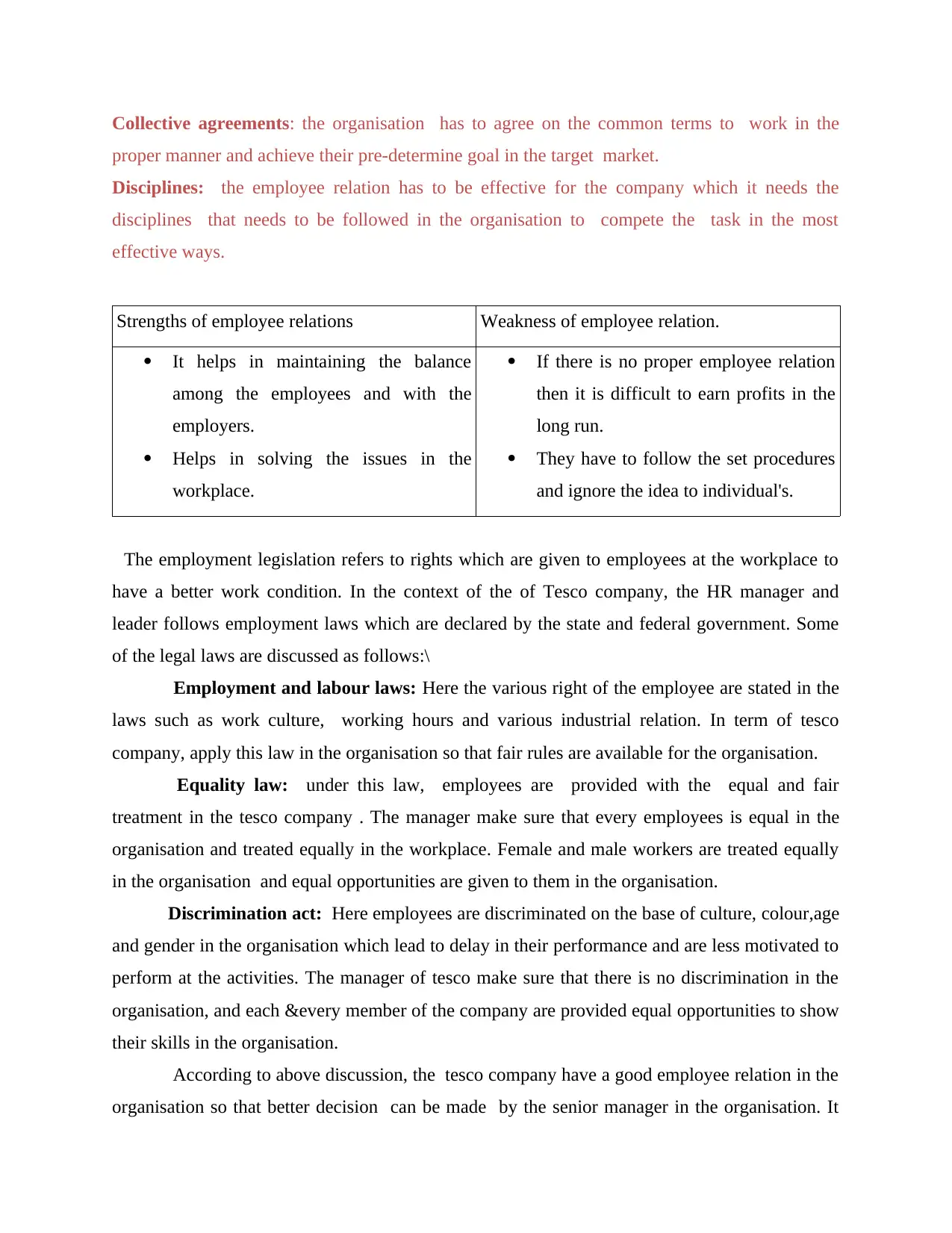
Collective agreements: the organisation has to agree on the common terms to work in the
proper manner and achieve their pre-determine goal in the target market.
Disciplines: the employee relation has to be effective for the company which it needs the
disciplines that needs to be followed in the organisation to compete the task in the most
effective ways.
Strengths of employee relations Weakness of employee relation.
It helps in maintaining the balance
among the employees and with the
employers.
Helps in solving the issues in the
workplace.
If there is no proper employee relation
then it is difficult to earn profits in the
long run.
They have to follow the set procedures
and ignore the idea to individual's.
The employment legislation refers to rights which are given to employees at the workplace to
have a better work condition. In the context of the of Tesco company, the HR manager and
leader follows employment laws which are declared by the state and federal government. Some
of the legal laws are discussed as follows:\
Employment and labour laws: Here the various right of the employee are stated in the
laws such as work culture, working hours and various industrial relation. In term of tesco
company, apply this law in the organisation so that fair rules are available for the organisation.
Equality law: under this law, employees are provided with the equal and fair
treatment in the tesco company . The manager make sure that every employees is equal in the
organisation and treated equally in the workplace. Female and male workers are treated equally
in the organisation and equal opportunities are given to them in the organisation.
Discrimination act: Here employees are discriminated on the base of culture, colour,age
and gender in the organisation which lead to delay in their performance and are less motivated to
perform at the activities. The manager of tesco make sure that there is no discrimination in the
organisation, and each &every member of the company are provided equal opportunities to show
their skills in the organisation.
According to above discussion, the tesco company have a good employee relation in the
organisation so that better decision can be made by the senior manager in the organisation. It
proper manner and achieve their pre-determine goal in the target market.
Disciplines: the employee relation has to be effective for the company which it needs the
disciplines that needs to be followed in the organisation to compete the task in the most
effective ways.
Strengths of employee relations Weakness of employee relation.
It helps in maintaining the balance
among the employees and with the
employers.
Helps in solving the issues in the
workplace.
If there is no proper employee relation
then it is difficult to earn profits in the
long run.
They have to follow the set procedures
and ignore the idea to individual's.
The employment legislation refers to rights which are given to employees at the workplace to
have a better work condition. In the context of the of Tesco company, the HR manager and
leader follows employment laws which are declared by the state and federal government. Some
of the legal laws are discussed as follows:\
Employment and labour laws: Here the various right of the employee are stated in the
laws such as work culture, working hours and various industrial relation. In term of tesco
company, apply this law in the organisation so that fair rules are available for the organisation.
Equality law: under this law, employees are provided with the equal and fair
treatment in the tesco company . The manager make sure that every employees is equal in the
organisation and treated equally in the workplace. Female and male workers are treated equally
in the organisation and equal opportunities are given to them in the organisation.
Discrimination act: Here employees are discriminated on the base of culture, colour,age
and gender in the organisation which lead to delay in their performance and are less motivated to
perform at the activities. The manager of tesco make sure that there is no discrimination in the
organisation, and each &every member of the company are provided equal opportunities to show
their skills in the organisation.
According to above discussion, the tesco company have a good employee relation in the
organisation so that better decision can be made by the senior manager in the organisation. It
Paraphrase This Document
Need a fresh take? Get an instant paraphrase of this document with our AI Paraphraser
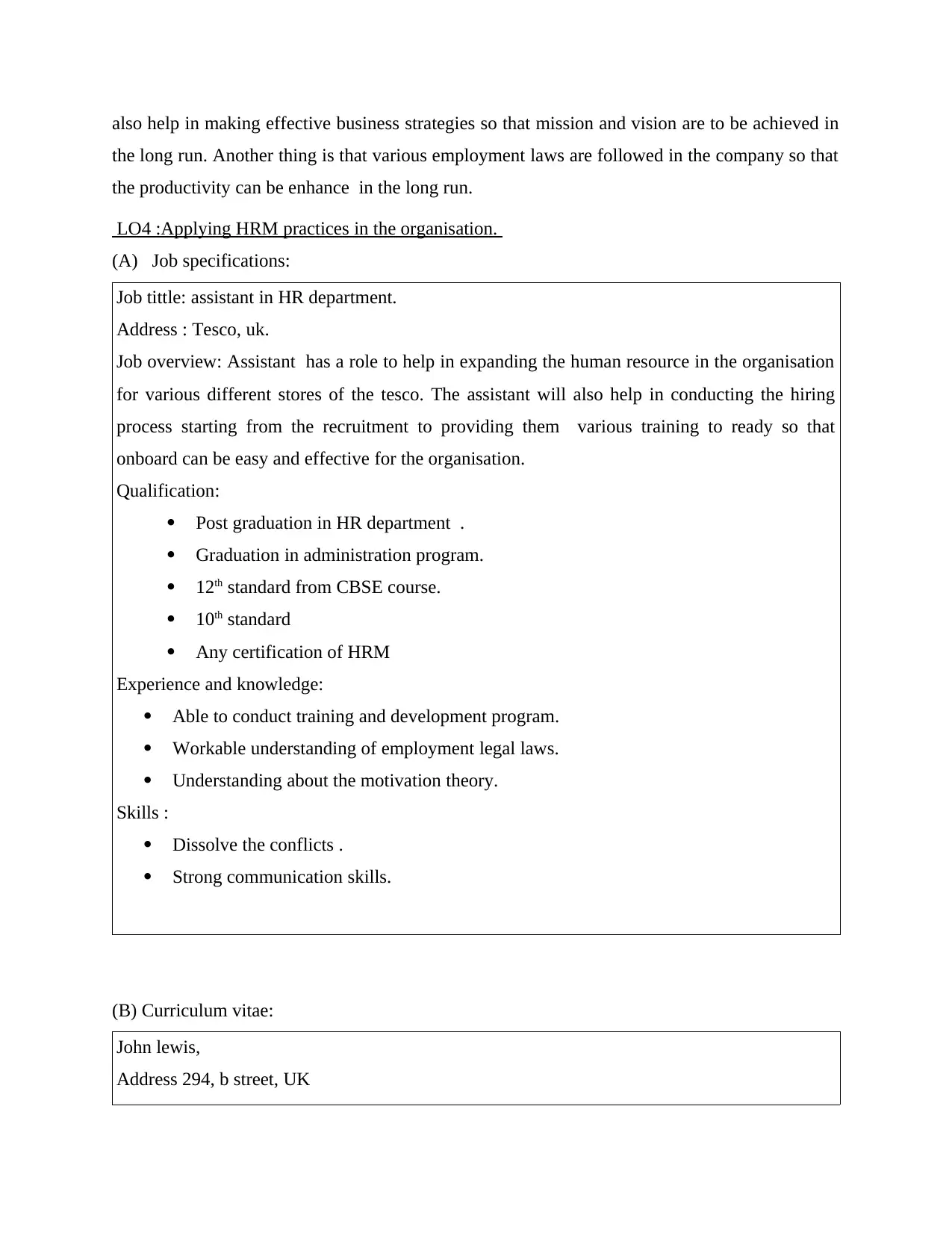
also help in making effective business strategies so that mission and vision are to be achieved in
the long run. Another thing is that various employment laws are followed in the company so that
the productivity can be enhance in the long run.
LO4 :Applying HRM practices in the organisation.
(A) Job specifications:
Job tittle: assistant in HR department.
Address : Tesco, uk.
Job overview: Assistant has a role to help in expanding the human resource in the organisation
for various different stores of the tesco. The assistant will also help in conducting the hiring
process starting from the recruitment to providing them various training to ready so that
onboard can be easy and effective for the organisation.
Qualification:
Post graduation in HR department .
Graduation in administration program.
12th standard from CBSE course.
10th standard
Any certification of HRM
Experience and knowledge:
Able to conduct training and development program.
Workable understanding of employment legal laws.
Understanding about the motivation theory.
Skills :
Dissolve the conflicts .
Strong communication skills.
(B) Curriculum vitae:
John lewis,
Address 294, b street, UK
the long run. Another thing is that various employment laws are followed in the company so that
the productivity can be enhance in the long run.
LO4 :Applying HRM practices in the organisation.
(A) Job specifications:
Job tittle: assistant in HR department.
Address : Tesco, uk.
Job overview: Assistant has a role to help in expanding the human resource in the organisation
for various different stores of the tesco. The assistant will also help in conducting the hiring
process starting from the recruitment to providing them various training to ready so that
onboard can be easy and effective for the organisation.
Qualification:
Post graduation in HR department .
Graduation in administration program.
12th standard from CBSE course.
10th standard
Any certification of HRM
Experience and knowledge:
Able to conduct training and development program.
Workable understanding of employment legal laws.
Understanding about the motivation theory.
Skills :
Dissolve the conflicts .
Strong communication skills.
(B) Curriculum vitae:
John lewis,
Address 294, b street, UK
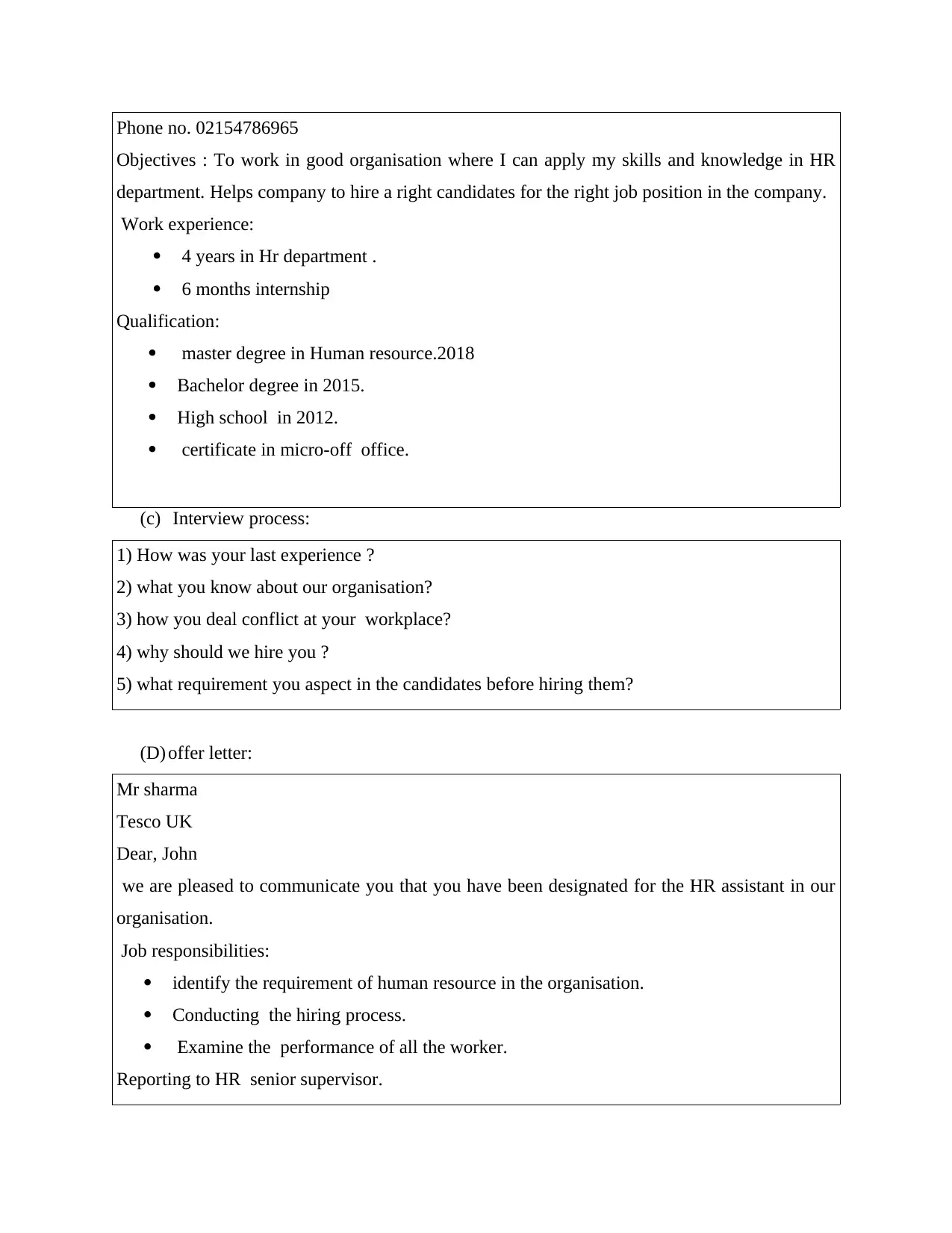
Phone no. 02154786965
Objectives : To work in good organisation where I can apply my skills and knowledge in HR
department. Helps company to hire a right candidates for the right job position in the company.
Work experience:
4 years in Hr department .
6 months internship
Qualification:
master degree in Human resource.2018
Bachelor degree in 2015.
High school in 2012.
certificate in micro-off office.
(c) Interview process:
1) How was your last experience ?
2) what you know about our organisation?
3) how you deal conflict at your workplace?
4) why should we hire you ?
5) what requirement you aspect in the candidates before hiring them?
(D) offer letter:
Mr sharma
Tesco UK
Dear, John
we are pleased to communicate you that you have been designated for the HR assistant in our
organisation.
Job responsibilities:
identify the requirement of human resource in the organisation.
Conducting the hiring process.
Examine the performance of all the worker.
Reporting to HR senior supervisor.
Objectives : To work in good organisation where I can apply my skills and knowledge in HR
department. Helps company to hire a right candidates for the right job position in the company.
Work experience:
4 years in Hr department .
6 months internship
Qualification:
master degree in Human resource.2018
Bachelor degree in 2015.
High school in 2012.
certificate in micro-off office.
(c) Interview process:
1) How was your last experience ?
2) what you know about our organisation?
3) how you deal conflict at your workplace?
4) why should we hire you ?
5) what requirement you aspect in the candidates before hiring them?
(D) offer letter:
Mr sharma
Tesco UK
Dear, John
we are pleased to communicate you that you have been designated for the HR assistant in our
organisation.
Job responsibilities:
identify the requirement of human resource in the organisation.
Conducting the hiring process.
Examine the performance of all the worker.
Reporting to HR senior supervisor.
⊘ This is a preview!⊘
Do you want full access?
Subscribe today to unlock all pages.

Trusted by 1+ million students worldwide
1 out of 16
Related Documents
Your All-in-One AI-Powered Toolkit for Academic Success.
+13062052269
info@desklib.com
Available 24*7 on WhatsApp / Email
![[object Object]](/_next/static/media/star-bottom.7253800d.svg)
Unlock your academic potential
Copyright © 2020–2026 A2Z Services. All Rights Reserved. Developed and managed by ZUCOL.





